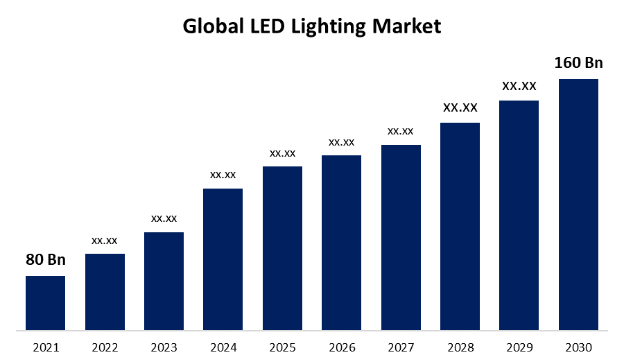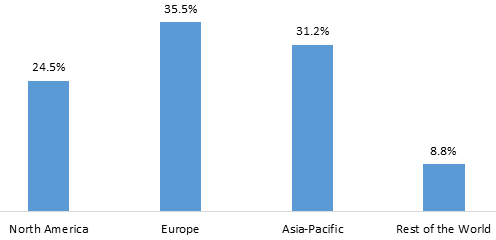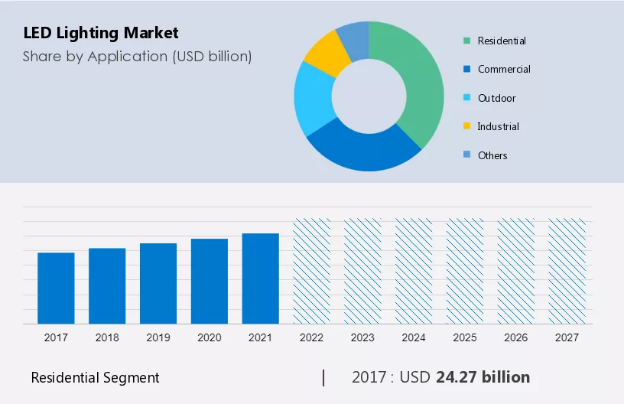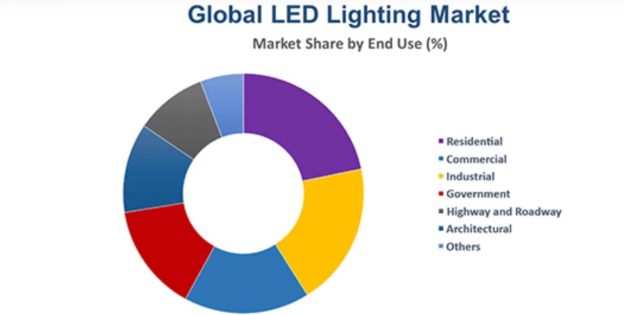LED lighting has massively taken over traditional lighting fixtures. Every space is now equipped with LED lights, and they have replaced the fluorescent and incandescent lights worldwide. This demand for LED lighting shows that the market growth of LED lighting will be quite impressive in the near future.
When considered at the global value, the LED lighting market was valued at $72.12 billion in the year 2022. However, it is growing at a massive rate and is expected to grow at a CAGR(Compound Annual Growth Rate) of 12.31% from 2023 to 2032. It is also expected that by the year 2032, the LED lighting market will reach $230.27 billion. The low energy component and cost-effective lighting solution offered by LED lead to such growth.
| Aspects | Description |
| Market Size | Revenue (USD Billion) |
| Market size value in 2022 | USD 72.12 Billion |
| Market size value in 2032 | USD 230.27 Billion |
| CAGR (2023 to 2032) | 12.31% |
| Forecast | 2023-2032 |
| Region | The data shown features the markets of Europe, North and South America, Africa, Asia Pacific and Middle East. |
| Segments | Type, Installation, Application and Sales Channel |
If you are looking forward to knowing more about the LED market growth and its dynamics, you are at the right place; this guide below features every detail, so let’s read below:
Market Introduction:
LED lighting is more efficient than incandescent or fluorescent lights. They consume less energy and are more durable than us. The LED lights are used for illumination as LED bulbs or lighting fixtures.
LEDs are smaller in size and have multiple design options to offer. Some LED bulbs even look like traditional ones, and there are multiple colors: red, green, blue, and amber. The different LED colors are combined to create white light, the most common in most places.

Market Dynamics:
The market dynamics of LED lighting can be divided into various segments, and some of these are discussed below:
Drivers
The use of LED lighting in commercial and industrial applications is increasing quickly because of the unique features these LED lights have. Compared to traditional lights, the LEDs are more durable and need less maintenance.
LED lights are also known for their extensive lifespan, which ranges between 50000 and 100000 hours. It can even save electricity expenses up to 80 percent. LED lights can be offered in various designs and unique display layouts, including opting for lighting that helps business owners focus the products on display.
Restraints:
The LED lighting also comprises some restraints. Every country has different restrictions on LED lights. However, one of the most common restraints that almost everyone faces is the high initial investment. The creation of the entire LED lighting system design is expensive, and it is because of the components present in these lights.
Opportunities:
The growth of the construction industry is directly linked to the growth of the LED lighting industry. The construction industry also uses high-quality materials and technological innovations, which boosts the LED market.
No matter if the construction industry stays inclined to bring more commercial projects or more residential projects, the demand for LED lighting systems will increase as these are implemented into such projects. Hence, the growth of construction projects will also increase the demand for LED lighting.
Regional segmentation analysis:
The major shareholder of the LED lighting market is Asia Pacific, and the expected growth at a CAGR of 14.6 percent is foreseen during the forecast period. The Asia Pacific region comprises LED lighting businesses that can cater to a maximum number of people. Also, increasing construction in Asia Pacific could lead to a demand for LED lights. LED lighting has been adopted in all areas in the past few years compared to other lighting methods.
On the other hand, Europe also has a CAGR of 11.7%, and when it comes to looking at the domestic sector in the UK, about 14 percent is dependent on LED lighting. This application can be seen in residential spaces. Moreover, France, Germany, and the UK are looking forward to increasing energy efficiency and cost-effectiveness in their lighting practices, and for this, the implementation of LED lights is quite commonly observed.
On the other hand, the North American market has also seen a consistent increase in the use of LED lights. They are also using LED street lights in some smart cities of America, including Los Angeles, Detroit, New York, Boston, Portland, and San Francisco. The LED status of street lights has reduced energy consumption by 50% and helps save maintenance expenses.
Since LED lights offer multiple benefits like energy saving, durability, and noise reduction, residential spaces are now also opting for LED lighting systems to boost the market growth in the region.

Type Segment Analysis
Regarding lamp type, the global market comprises segments in the form of A lamps, T lamps, and other types of lamps. According to the first, the A-lamps capture a high market share, and the growth of this share is based on a CAGR of 13.7%, type A LED bulbs comprise plug-and-play bulbs and can directly replace traditional fixtures.
T-type lamps are primarily used in residential spaces, offering better efficiency and reducing maintenance expenses. Using smart technology, they offer soft lights with maximum energy and help save power. Moreover, compared to the traditional incandescent bulb, the lifespan of LED light is much longer.
The global market divides luminaire types into street lights, troffers, downlights, and other luminaires.
The downlights offer the highest market contribution with their CAGR at 12.1 percent growth, and they consume less electricity, offering a high quality and bright light.
Also, with the increasing urbanization and the government’s initiatives to save electricity, LED lighting solutions have become prevalent. Streetlights play a magnificent role in this market share because the demand for streetlights increases energy consumption when traditional lighting options are used. However, replacing them with LED lights helps to reduce energy consumption.
Installation Segment Analysis
The analysis of the installation segment considers two aspects: the new and the retrofit. The new segment has a market share of around 78% as of 2022; when users want a complete change of the look in interiors, they look for a change of fixture. Moreover, if the fixture is badly damaged, a new fixture is also needed.
Application Segment Analysis
The application of LED lighting can be seen in two divisions: the indoor and outdoor segments.
The indoor segment owns a significant share of the market and has an expected growth of 12.6%; it is because the demand for fluorescent and other lighting fixtures has been reduced in malls, superstores, and other indoor spaces and is taken over by LED lighting. Since LED lights are eco-friendly, they are opened by educational institutions and the healthcare sector.
The outdoor segment, on the other hand, has seen moderate growth in the market share, and it is because the infrastructure of every place is improving and the evolution of public space, motorways, and airports and the implementation of LED lights in such places due to energy savings has got a hold of LED lights markets.

Sales Channel Segment Analysis
The sales channel segment comprises retail, online, and direct sales. The retail segment has the highest share, more than 50%.
Some of the Key Market Players:
Some of the key players in the LED market comprise Signify Holding, which tops the list. This company manufactures capacitors and diodes as the most important LED lighting component.
OSRAM, Dialight, Hubbell Lighting, LumiGrow, and many more have their production plant set up in developing countries as they can save on labor costs, so their LED lighting systems are also affordable.
Key Companies & Recent Developments
The companies that hold a significant share in the LED lighting industry have been spending a lot of money on production lines so that the LED lighting market grows more.
The key players in the LED lighting market, comprising Philips Lighting, Samsung Electronics, GE Lighting, Eaton Corporation, Sharp Corporation, etc, have been expanding their research and development to ensure market demand increases.
As far as the industry developments are concerned, some of these comprise the following:
- In October 2021, Signify Holdings, a subsidiary of Phillips, launched its downlight known as Philips HexaStyle Downlight. It offers hexagonal LED solutions for ceilings in different layouts.
- In July 2020, Savant System Inc., a company that offers smart home solutions, acquired a lighting business from GE Lighting, allowing it to provide customers with innovative LED lighting solutions.
- In October 2021, Skyview Capital acquired a digital lighting business from OSRAM that allied the company to enter the intelligent LED business.
- Wipro Lighting, partnered with Enlight in June 2021, offers LED lights and luminaries and IoT-based lighting software, offering its customers an exceptional lighting experience.
- In June 2022, DEDO Lights and Prolycht, its partner company, announced the launch of a new lighting system known as the RGBLAC LED lighting system, which offers a 6:1 variation spotlight beam.

Global LED Lighting Market Segmentation
LED lighting market size in the year 2021 was valued at $57.9 Billion, and by 2030, it is expected to grow to 135.36 billion 2030 with a CAGR of 11.2 percent.
FAQs:
1. Is the future of the LED lighting industry?
Ans. The fixture of the LED lighting industry is promising because this industry is revolutionizing, and the developments that are taking place are fascinating.
2. What is the demand for LED lights?
Ans. The LED lighting industry is expected to see a CAGR of 11 percent from 2023 to 2030; by 2030, it is expected to reach $168.87 billion.
3. What is the current status of the LED industry?
Ans. The size of the LED industry currently is estimated at $111.57 billion.
4. What are two possible future applications of LED lights?
Ans. IoT-compatible LED lighting, which helps optimize heating and air conditioning, power grid management, and wireless communication based on next-generation technology, are possible future applications.
5. Are LED Lights profitable?
Ans. Yes, LED lights are equipped with affordability; they generate less heat and also consume less power, all of which makes them profitable.
6. Why are LEDs becoming popular?
Ans. The reason behind the popularity of LEDs is their reduced energy consumption, which helps save on electricity bills, and their durability, hence also helping to reduce maintenance costs.
7. What are the challenges of the LED lighting industry?
Ans. The LED lighting industry faces the challenges of thermal design; these lights generate a lot of heat, which needs aluminum heat sinks in a particular design, and it requires a lot of effort to manufacture those heatinks in such a specific design.



